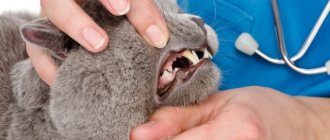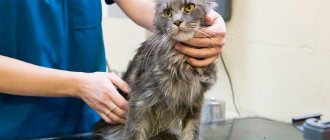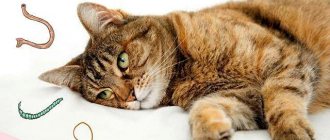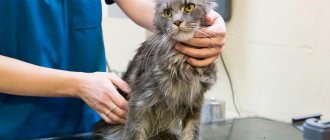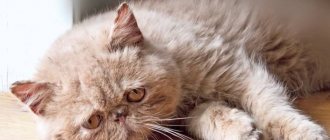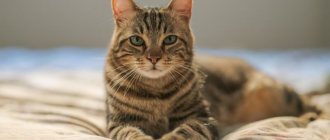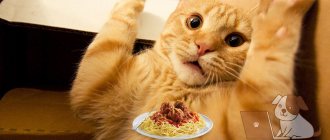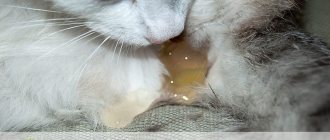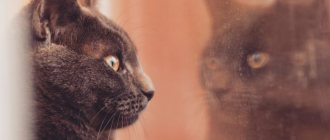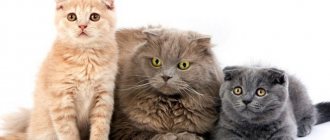Cats always give the impression of being extremely clean animals, as they lick their entire body for a long time to maintain hygiene. They do this not so much to remove dirt as to neutralize a specific odor. Since the cat’s tongue is always visible, it is not surprising that with its pathologies, the owner quickly notices signs that something is wrong. In particular, you should be wary if you notice a white tongue on a cat.
Causes of gum discoloration
If you lift your pet's lip, the owner will see the condition of his gums. They can be red, as if bloodshot and ulcerated, pale or almost white, yellow and even blue-black. What leads to such changes:
- Inflammation of the gums, their redness and the appearance of aphthae (ulcers) can be caused by serious kidney pathology (renal failure), intestinal diseases and diabetes.
- Bright, bloodshot gums, red edging around the teeth and bad breath are signs of gingivitis. It is usually accompanied by periodontal pathology.
- Reddened gums with ulcers and an ulcerated tongue are signs of calcivirosis. The disease is accompanied by high fever, intestinal disorders, and dehydration.
- Pale pink gums, when pressure is applied to them, a white spot (the site of bleeding) is formed, which is difficult to return to color, may be a sign of anemia (including caused by blood loss) and shock. In this case, the animal is weakened, lethargic, and refuses food.
- Yellow gums and ears, as well as the whites of the animal's eyes, are a sign of jaundice. It can develop as a result of hemolytic anemia (occurs due to the destruction of red blood cells) or mechanical blockage of the biliary tract. Rupture of the gallbladder leads to jaundice and then the death of the animal. Liver pathologies (hepatitis, fatty degeneration), tumors that mechanically compress the bile ducts, severe poisoning with hepatotoxins cause yellow discoloration of the gums. In this case, the animal’s feces become discolored, while the urine, on the contrary, becomes dark and rich, like orange juice. The cat develops severe thirst and lacks appetite. The animal has a fever, the cat’s stomach is painful.
- Yellowing of the gums can occur due to poisoning with severe poisons. This occurs because the animal's liver stops functioning.
- Cholecystitis and other pathologies of the biliary tract also cause yellowness on the gums.
- Pale, almost white gums can be a sign of viral leukemia in a cat. Leukemia is an incurable viral disease in cats associated with changes in immune cells - leukocytes - by the virus. As a result, the animal's immune system is unable to perform its functions. This disease has no specific symptoms. The cat often suffers from stomatitis, gingivitis, and suffers from intestinal disorders. At the last stage, cancerous tumors appear.
- White gums may appear after taking antiparasitic medications. All of these drugs are quite toxic. If the cat is active and eats well, there is no need to worry. If the cat's general condition worsens, he should be taken to the veterinarian.
- When the gums are injured, the animal develops bluish spots (hematomas). In this case, the cat may refuse to eat and drink. When a cat's gums are punctured, necrosis may begin. At the site of the lesion, the tissues turn black, and an unpleasant odor appears from the mouth. The animal refuses food.
- With a myocardial infarction, a cat may have pale or bluish gums and lips. At the beginning of the attack, the cat may scream loudly. Then she becomes apathetic, moves slowly and uncertainly, or even lies down. Without assistance, the animal may die.
- Acute heart failure can occur suddenly and develop rapidly. In this case, one of the symptoms is blue gums.
- With asphyxia, cyanosis of the gums is also observed. This happens when foreign objects, swelling of the larynx, or insect bites enter the upper respiratory tract. The minutes count; if help is not provided on time, the animal may die.
- In acute pulmonary failure, the cat may breathe heavily and loudly and wheeze. At the same time, the gums will also turn blue.
- An animal's gums, lips and eyelids may become blue during an attack of bronchial asthma. At the same time, the cat wheezes, coughs, falls to the side and suffocates. The color of the gums may change with severe respiratory failure and in some other cases.
However, there are situations when the change in gum color is physiological and should not bother the breeder.
For example, in kittens up to 6 months of age, active teeth change occurs. In this case, the gums may not only be excessively red, but also swollen. Increased salivation is observed, and the animal may be restless. The breeder needs to show maximum attention to the pet: surround it with care and monitor the condition of the gums. There should be no purulent ulcers or wounds on them. It is recommended to thoroughly clean the kitten's oral cavity and monitor the correct growth of teeth.
Symptoms and diagnosis of gingivitis
If the cat becomes lethargic , begins to refuse even its favorite food, is unmotivatedly irritable and aggressive, it should be suspected that it has gingivitis. However, all this can be symptoms of many diseases.
The owner needs to examine the oral cavity of his pet.
These symptoms are most easily seen at the line where the tooth enters the gum. Usually, at this stage of the disease, there is already an unpleasant odor from the cat’s mouth , which is caused by the processes of rotting food debris and the proliferation of bacterial microflora. By the way, another sign of gingivitis is excessive salivation .
In the later stages of the disease, the animal loses interest in food , since it physically cannot chew it, exhaustion, and apathy.
At a veterinary clinic, specialists usually order an x-ray examination. Sometimes a biopsy and tissue collection for histological examination are required.
Your doctor may recommend testing to detect leukemia and the immunodeficiency virus. Blood and urine tests may be ordered, but these tests are usually useless for diagnosing gingivitis.
Symptomatic treatment
If there is any change in the color of the gums, you should take your pet to the vet. Many of the pathologies that are accompanied by a change in the color of visible mucous membranes are serious, some require long-term treatment or emergency care, and some can cause the death of a pet.
The veterinarian will help you correctly determine the cause of the color change and select adequate treatment. In some cases, an ultrasound, complete blood count, computed tomography or x-ray may be required for a more accurate diagnosis.
So, if a foreign body gets in and it is impossible to remove it mechanically, an emergency operation is performed.
For bites and allergic reactions, antihistamines are recommended. In case of poisoning, gastric lavage is effective.
In the case of pathologies of internal organs, the cause that caused the change in gum color is treated. Prescribe a therapeutic diet if necessary.
For diseases of the oral cavity, ointments, sprays and solutions of medications are prescribed. The cat's mouth is treated with cotton swabs.
Injuries are treated locally, decongestants and cold compresses are prescribed to the site of bruises.
More serious problems
Thus, a cat's tongue can be a real "barometer" of health. A change in color is an indicator that your cat may be sick. You can remember a simple truth: “A pink tongue is a healthy pet.” This rule is immutable; exceptions are very rare.
Why is that? The fact is that the tongue, as a muscular organ, is literally penetrated by many blood vessels, visible through the thin epithelial layer. If it is pink, everything is in order - the blood supply is normal, the red blood cells contain the required amount of hemoglobin. In many cases, a white tongue is a sign of poor oral hygiene , but below we will describe much more serious pathologies in which this organ also changes its color.
Symptomatic diet and procedures
Changing gum color is always a cause for concern. Even a banal change of teeth in a kitten should not go unnoticed by the breeder.
And pathological conditions require mandatory consultation with a veterinarian; in some cases, a visit to the veterinary clinic can be very urgent.
For the speedy recovery of the animal, it is very important to strictly follow the specialist’s recommendations. Any medications should be administered only in the recommended dosage and not exceed it.
If your cat's gums are red due to oral diseases, then folk remedies can help. It is recommended to irrigate the mouth with decoctions of sage or oak bark after each meal. The procedure is performed using a syringe without a needle. You need to tilt the cat's head down so that it does not swallow the contents of the syringe.
To ensure that oral diseases bother your cat as little as possible, you need to regularly clean the mouth and teeth of plaque and tartar. To do this, use a soft toothbrush.
In case of diseases of the internal organs, it is necessary to normalize the cat’s daily menu, exclude harmful foods from it and supplement the diet with vitamins.
It is necessary to ensure that your cat always has fresh drinking water. The food in the bowl must also be extremely fresh.
If a cat has suffered swelling from an insect bite or a blow, or severe poisoning, then you should carefully monitor the animal’s further behavior. If symptoms of damage to internal organs or the oral cavity appear, you should contact your veterinarian again.
Preventing gum disease in cats
- Regular preventive examinations of the cat's oral cavity. If small wounds, ulcers, or an unpleasant odor appear, you should consult a doctor for a diagnosis.
- Proper nutrition. If you use ready-made food, you must choose premium mixtures. For prevention, twice a year you can give your cat a specialized “medicinal” food for a week, which contains ingredients that cleanse the oral cavity.
- Regular brushing of teeth . Ideally, your cat's teeth should be brushed 2-3 times a month, using veterinary medicinal products to remove plaque.
Diagnosis of possible diseases
Diagnostic measures include an integrated approach. Suspecting the development of anemia in a cat, the doctor takes into account the clinical manifestations and also prescribes a number of laboratory tests. An obligatory point of diagnosis is the collection of anamnesis.
A blood test is performed to determine the processes occurring in the bloodstream, as well as to determine the possible development of inflammation. If a bone marrow dysfunction is suspected, a bone marrow puncture is prescribed. Based on the data obtained, the veterinarian prescribes therapy.
When gum redness is a physiological norm
There is only one exception, when the pet's gums change color and do not require veterinary care, but supervision by both the owner and the veterinarian is required. Redness of the gums, caused by their irritation, can normally only occur in kittens during the period of changing teeth - up to 6 months. However, it is moderate in nature, localized in the area of teeth undergoing physiological replacement, and never completely covers all the arcades - since the timing of the change differs for different teeth.
The swelling is also moderate, and there is no pronounced overhang of the gums. There are no purulent discharges, as well as filmy deposits of fibrin, ulcerative defects on the surface of the mucous membrane. But despite the fact that this process is a physiological norm, experienced breeders pay maximum attention to the kitten during this period of life, since teething is a real test for the pet’s immune system, as well as a crucial period for the formation of correct dentition and bite, which will subsequently ensure effective chewing and the appearance of the pet’s face, characteristic of its breed. The kitten needs to monitor the timing of teething, the absence of conflict between them, monitor the condition of the oral mucosa and carefully clean it.
When changing teeth, the redness of the gums is moderate.
Breeds Predisposed to Gingivitis
There are a number of breeds that are predisposed to developing gingivitis:
- British;
- Persian;
- Burmese;
- Siamese;
- Abyssinian;
- Bengali;
- Maine Coon.
Gingivitis in these breeds occurs due to the breed's structural features of the skull, and therefore the jaws, for example, in brachycephalic cats.
Maine Coons have a hereditary predisposition to gingivitis
Periodontal disease
Symptoms:
- Bad breath. One of the main reasons for visiting a veterinarian. The smell from the mouth becomes unbearable, putrid in nature, and can be felt from afar (when the animal enters the room).
- Decreased appetite. The cat wants to eat, but cannot. Refuses the once-favorite “crackers”, preferring soft food.
- Strange behavior. Owners notice how the pet shakes its head, rubs its muzzle with its paw, as if trying to get something out of its mouth. Sometimes you can clearly hear teeth grinding. The cat slurps when chewing. After eating, the lower jaw may tremble.
- Constant discharge from the mouth. A sick animal will drool profusely. Blood or pus may occasionally leak from the mouth. The fur on the chin is wet all the time, the skin becomes inflamed.
- Tartar and gum inflammation. If the cat is calm, you can move the upper lip and look into the mouth without opening its mouth. It is easy to notice yellow-brown tartar - massive hard deposits that sometimes completely cover the tooth itself. The gums are bright red or bluish in color and bleed. When pressed, a pus-like gray mass may come out from under it.
Treatment:
1. Hygienic cleaning of teeth from plaque and tartar at the initial stage of the disease. After this procedure, the crowns are coated with a fluoride-containing protective varnish. I treat the gums with antiseptic solutions and dental ointments (for example, Metrogil Denta).
2. Surgical intervention.
============================================================================================================================================================================================
What to do at home
The owner must provide his pet with the most comfortable living conditions and strictly follow the veterinarian’s instructions. You should not self-medicate, as this can aggravate the situation and cause irreparable harm to the cat’s health.
You can alleviate the suffering of a fluffy with the help of a soda solution or decoctions of medicinal herbs that have a disinfectant and antimicrobial effect. However, traditional methods cannot replace traditional treatment and are used as additional measures.
A decoction of chamomile, oregano, and strawberry leaves has worked well. You need to boil 1 teaspoon of the dried plant, pour a glass of boiling water, and cook over low heat for 10 minutes. Then strain the broth, cool and use to wipe the animal’s mouth.
During gingivitis, a cat usually refuses to eat, since even a small, barely chewed piece causes her pain. However, to defeat pathology, the body needs strength. Your four-legged pet should be fed with special soft food intended for weakened cats, pureed meat and vegetables, meat or chicken broth.
Cat's dental system
The organization of the animal's dental system has its own distinctive features. It consists of the following teeth:
- incisors – located in front, with their help the pet captures prey;
- fangs - designed for tearing prey;
- premolars - used for chewing food;
- Molar teeth - designed for crushing food.
From birth, animals have no teeth. After about two weeks, the first incisors appear, followed by fangs and root teeth. Teeth erupt approximately until the end of the first month of life. In total, a cat has 26 baby teeth - 14 at the top and 12 at the bottom.
Between four and eight months, baby teeth are replaced by permanent teeth. During the same period, 4 more teeth grow. In total, an adult animal has 30 teeth - 16 at the top and 14 at the bottom.
What factors contribute to the development of gingivitis?
Gingivitis is an inflammatory process that develops in the gums, affecting the area around one or more teeth. Gum inflammation is the beginning of a destructive syndrome in the tissues surrounding the bone structure.
The mechanism of action of gingivitis is as follows: first it affects the gums, then the ligaments and bones on which the teeth are attached. According to veterinarians, gingivitis is nothing more than the beginning of a difficult and difficult to treat disease - periodontal disease.
The reasons that provoke the development of gingivitis can be divided into internal (endogenous) and external (exogenous). Internal factors include:
- vitamin deficiency;
- abnormal arrangement of the lower and upper teeth at the moment of closing the jaws (bite);
- hardened plaque;
- caries.
External causes of the disease are considered:
- wounds of the oral cavity caused by tubular bones and other sharp objects;
- radiation received as a result of radiation therapy, x-rays, etc.;
- infections;
- viruses (calcivirus, herpes, etc.);
- exposure to chemical elements.
Gingivitis can occur in any pet, regardless of breed; at risk are animals aged 5 years and older, an unbalanced diet, blood pathologies, and autoimmune diseases.
Development of periodontitis
This disease involves inflammation of the tissues around the root and develops due to many factors. The most common are bruises, inflammation, cracks in the pet’s mouth. The main symptoms are swelling of the area around the teeth, pain, as well as refusal to eat, changes in behavior. A tooth located in the area of inflammation may become loose.
Therapy involves the use of special disinfectant solutions. The pet’s mouth is washed with such liquids. A good effect can be achieved using an infusion of calendula flowers - the herbal preparation effectively eliminates inflammatory processes and kills microbes. With purulent-diffuse periodontitis, tooth extraction is most often resorted to.
Animal nutrition for gingivitis
For gingivitis, in addition to taking medications, it is important to provide your pet with the right diet. So, solid foods (raw vegetables, fibrous meat, granulated food) should be excluded from the animal’s menu. An approximate menu for a cat with gingivitis is as follows:
- High-quality wet food or pate (if the cat is accustomed to ready-made food);
- Well-cooked meat (and fish) in pureed form;
- Puree of boiled vegetables;
- Fermented milk products (cottage cheese, kefir, natural yogurt);
- Slimy liquid porridges (oatmeal, rice, etc.).
If you have gingivitis, it is appropriate to feed your cat often, but in small portions, warming the food until it is lukewarm.

